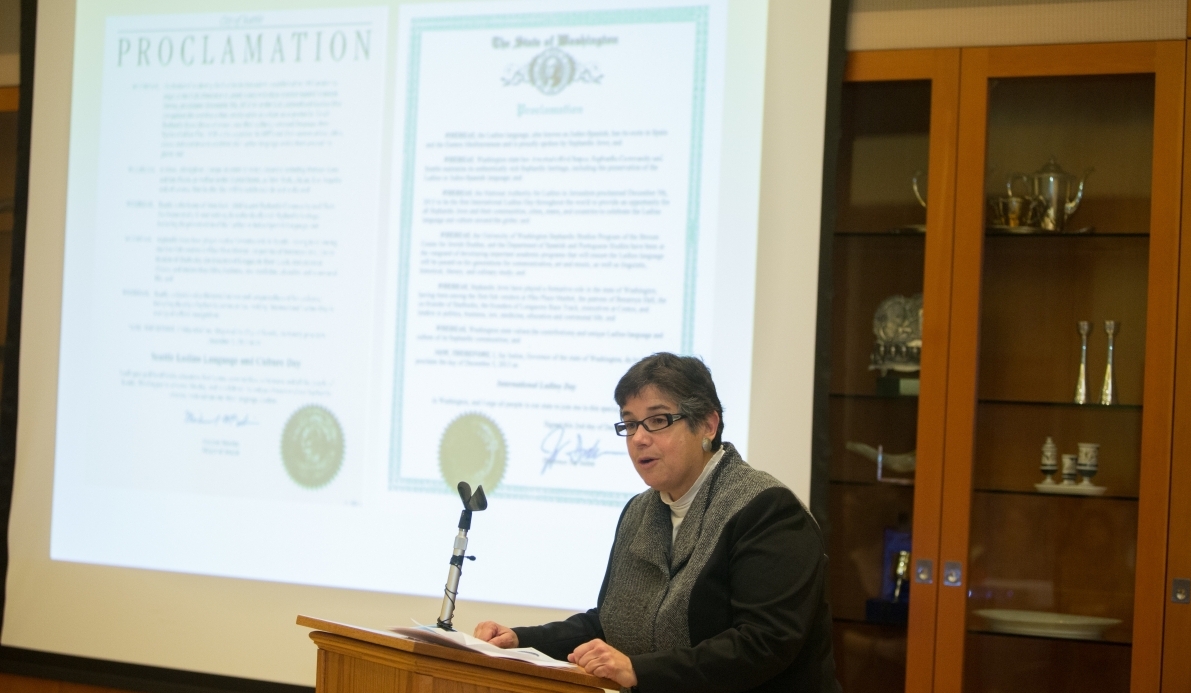
UW Provost Ana Mari Cauce read the Mayor’s Official Proclamation of Ladino Day on Dec. 5, 2013. Photo by Meryl Schenker.
Anyada buena i dulse. Tizku le-shanim rabot. Moed alegre!
2013-2014 marked a watershed year for Sephardic Studies at the University of Washington. As the Stroum Center for Jewish Studies celebrated its 40th anniversary, Sephardic Studies was born as an official university “Program.” Thanks to the generosity and vision of the Sephardic Studies Founders Circle and our many community supporters, like you, we have been able to grow and expand to an unprecedented extent. UW Sephardic Studies has much to celebrate and much to look forward to.
Benefitting from its home in the Stroum Center for Jewish Studies and the Jackson School of International Studies, our Sephardic Studies Program (SSP) has developed strong partnerships across campus and in the community. In this regard we have found an incredibly supportive home base and model in the Stroum Center, which has a strong tradition of connecting different groups on campus and exploring the diversity of Jewish experiences. In collaboration with the Stroum Center, the SSP has co-sponsored programs not only with the History Department, but also with the Division of Spanish and Portuguese Studies, Ottoman and Turkish Studies, Persian Studies, Hellenic Studies—and we’ve just gotten started.

Dr. Maureen Jackson spoke about Turkish Jewish sacred music in February 2014.
The SSP’s public programs drew more than 2000 participants during the 2013-2014 academic year. Our programs focused on connections between cultures: between synagogue liturgy and Ottoman court music (thanks to Dr. Maureen Jackson); between twentieth-century Ladino songs and their medieval (non-Jewish) Spanish precedents (discussed by Prof. Rina Benmayor); and, as shown in our co-sponsored Seattle Jewish Film Festival Sephardic Spotlight screening, between Italian fascism and the Jews of the Island of Rhodes, who were tragically deported to their deaths at Auschwitz.
Student Interest Blossoms
Students of a wide range of backgrounds have also expressed a pleasantly surprising degree of interest in Sephardic Studies courses. Our Ladino language classes provide the best example. When we invited Prof. David Bunis, chair of the Ladino Studies Program at Hebrew University in Jerusalem, to campus as a visiting Schusterman Professor, we hoped to attract ten students to his Introduction to Ladino. Amazingly, more than thirty signed up for the first term, and thirty-five for the second. UW thus became the only university in the entire country to teach undergraduates how to read and write Ladino in the traditional Hebrew scripts. While a few of the students were Jewish Studies students, many more were Spanish majors and minors or came from other departments. Now they all can read and write Ladino in rashi script.
Why such interest? As one undergraduate student explained, “objectively speaking, Ladino is interesting.” The student elaborated: “Through Ladino we learn the story of Jews who were living in Spain, who after being expelled from that country in the fifteenth century, travelled to the other end of the Mediterranean, settled in an Islamic empire [the Ottoman Empire], but still continued, for four or five hundred years, to speak a language based on medieval Spanish that they wrote in Hebrew letters and that included words not only from Spanish and Hebrew, but also Arabic, Turkish, Greek, French and Italian—and that, in the twentieth century, some of the last speakers of this language found their way to the United States, specifically to the Pacific Northwest, right here to Seattle. Now that is worth studying!”
In addition to learning Ladino, several undergraduate students have undertaken major research projects in Sephardic Studies, whether by conducting interviews with the last Auschwitz survivors from Rhodes who live in Seattle; studying family correspondence uncovered through our Sephardic Treasures Initiative; or exploring newspapers and censuses to map out Sephardic Seattle a century ago. Four graduating seniors in the UW History Department even dedicated their capstone projects to research on Sephardic Studies topics.
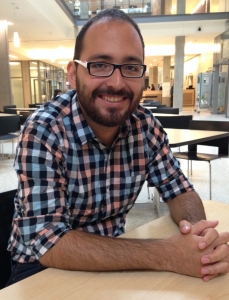
Oscar Aguirre-Mandujano won a Jewish Studies Graduate Fellowship to work on a unique notebook of poetry in Ladino and Ottoman.
UW’s Sephardic Studies Program is also becoming a center for graduate students, many of whom have received community-funded Jewish Studies Graduate Fellowships to support their projects. Molly FitzMorris completed her MA thesis on the last generation of Ladino speakers in Seattle and presented her research at a symposium at UCLA. The recipient of the 2014-15 I. Mervin and Georgiana Gorasht Scholarship, she is continuing this research as a PhD student in the UW Linguistics Department this fall. In her History Department dissertation, Sarah Zaides, last year’s Samuel and Althea Stroum Fellow, explores the permeable boundaries between Sephardi and Ashkenazi Jews by focusing on the migration of Russian Jews to the Ottoman Empire. Oscar Aguirre-Mandujano, last year’s Mickey Sreebny Memorial Scholar, studies the bilingual poetry of an Ottoman Jewish soldier and playwright who settled in Seattle after World War I. (You can read about his project in the Stroum Center’s Fall Newsletter.)
Making a Difference in Seattle and Beyond
It is only fitting for such a multipronged Sephardic Studies program to be centered in Seattle, home to one of the largest and most dynamic Sephardic communities in the country. It was in the 1930s, here at the UW, where the siblings Albert and Emma Adatto pioneered the field of Sephardic Studies, which has had a presence at UW ever since. Our Sephardic Studies Program continues their legacy not only of scholarship but also of engagement with local community members and institutions, thanks to partnerships with the Washington State Jewish Historical Society, the Stroum JCC, the Jewish Federation, Congregation Ezra Bessaroth, Congregation Sephardic Bikur Holim, and the Sephardic Brotherhood. In this regard, the SSP seeks to fulfill UW President Michael Young’s call to “turn the university inside out” by making our expertise accessible to our local communities, by developing mutually beneficial projects in partnership together, and by demonstrating the value of humanities, social sciences and digital innovation in the twenty-first century. I would like to highlight just two examples:
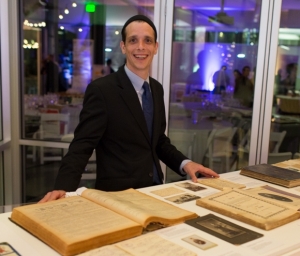
Ty Alhadeff with the exhibit of Seattle Sephardic Treasures at the Jewish Studies 40th Anniversary Gala. Photo by Meryl Schenker.
The Sephardic Studies Digital Library and Museum: Thanks to the generosity of members of the local community who have shared their books, family letters, and photographs with us, the UW Sephardic Studies collection now boasts more Ladino books than the Library of Congress or Harvard University. Thanks to the efforts of our Sephardic Studies Program Research Coordinator, Ty Alhadeff, more than eight hundred “Sephardic treasures” dating from the 16th to the 20th centuries are being digitized and will form the first comprehensive digital portal into the Sephardic experience. At the Stroum Center for Jewish Studies’ 40th Anniversary Gala, hosted at the Harley and Lela Franco Maritime Center, we curated an exhibition of some of the most notable treasures to come to light. One of these items even attracted a scholar from Spain who travelled all the way to the UW to study this book—the only known copy in the world. This coming year, we plan to digitize the top 500 Ladino titles we have collected so far, thus bringing our digital library and museum one step closer to fruition.
International Ladino Day: Participating with dozens of communities across the world in the first global celebration of Ladino language and culture, UW’s Sephardic Studies Program organized the Seattle festivities. The evening featured 30 presenters, ages 19 to 93, including students, faculty, and community members, who presented poems, songs, stories, jokes, and histories. More than three hundred people attended. The Seattle Mayor and Washington State governor officially endorsed our Ladino Day celebration; and UW Provost Ana Mari Cauce, Honorary Spanish Consul Luis Fernando Esteban, and the governor’s Senior Policy Advisor on Education Marcie Maxwell (née Halela) numbered among our many esteemed guests. Our second annual celebration of International Ladino Day is scheduled for December 4, 2014.
We are also proud that our SSP has garnered remarkable attention and support from the University and beyond. Our Program has been featured in a cover story for the UW alumni magazine Columns; in Perspectives: The Newsletter of the College of Arts and Sciences; and in the College of Arts and Sciences Year of Achievement video.
The birth of Sephardic Studies as an official UW “program” was an achievement not only for Jewish Studies, not only for our local community, but also for the University of Washington as a whole. The Attorney General’s Office of the State of the Washington even invited our Sephardic Studies Program to educate their staff about the culture of Sephardic Jews, who constitute one of the lesser-known yet highly significant populations in the state. A recent profile in Tablet Magazine; an article in the last remaining Ladino newspaper in the world, El Amaneser in Istanbul; a radio program on KUOW (the Seattle NPR affiliate); and a podcast from the Yiddish Book Center in Amherst, Massachusetts, brought much greater national and international attention to our efforts in Sephardic Studies.
What’s Ahead for 2014-15
We look forward to continuing to grow during the 2014-2015 academic year. Here is a preview of our public programs made possible in partnership with the Stroum Center for Jewish Studies:
~ New courses in Sephardic Jewish history and culture by Professors Ana Gomez-Bravo (on medieval Spain) and Devin Naar (from 1492 to the present)
~ The first artifacts and texts of the Sephardic Studies Digital Library and Museum will be made available online free to the public
~ The Second International Ladino Day celebration featuring an exciting lineup of student, faculty and community presenters and participants
~ A live concert by the famous Sarajevo-born Ladino singer, Flory Jagoda, in partnership with the Stroum Jewish Community Center
~ A screening of an acclaimed documentary film about the Holocaust in Greece, Kisses to the Children, followed by an in-person conversation with the director
~ The annual Stroum Lecturer will be the renowned anthropologist and writer Ruth Behar, a professor at the University of Michigan who specializes in Sephardic Jewish culture in Cuba
Whether you attend these events in person or connect with us virtually at our new web portal or on Facebook, we hope that you will join us in delving deeper into Sephardic history and culture this year. Pujados i non menguados – with your help, may our successes be increased and never diminished!


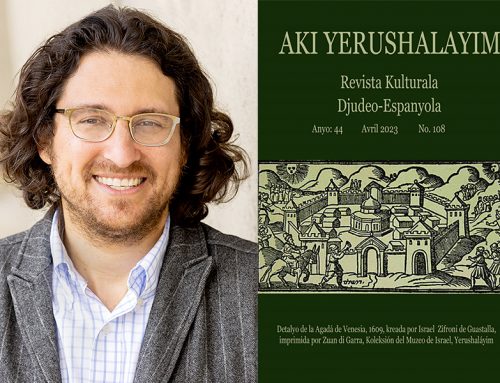

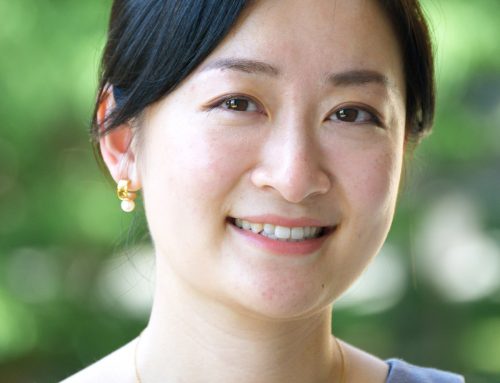
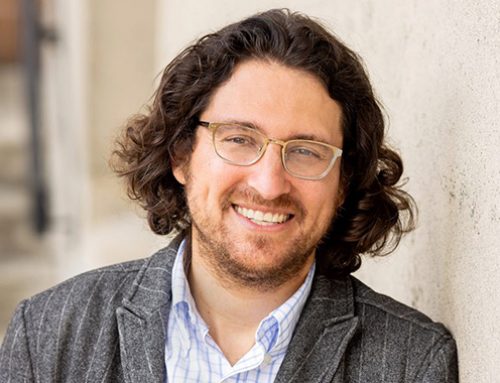
![Muestros Artistas [Our Artists]: Bringing Sephardic Art and Community Together at the UW](https://jewishstudies.washington.edu/wp-content/uploads/2023/08/UWJS_Muestros-Artistas-cropped-500x383.jpg)
My name is Diane Tafuri and my mother grew up in Salonika Greece. She came here to America in 1937 at age 23. My father’s parents were from Chanakal Le Turkey and came here in the early 1900s. I would love to find out more about their life and those two countries. My mother passed away three years ago at age 96.
Congratulations, as always, to Devin, and all involved in this fantastic program of Sephardic Studies at UW.
Rachel